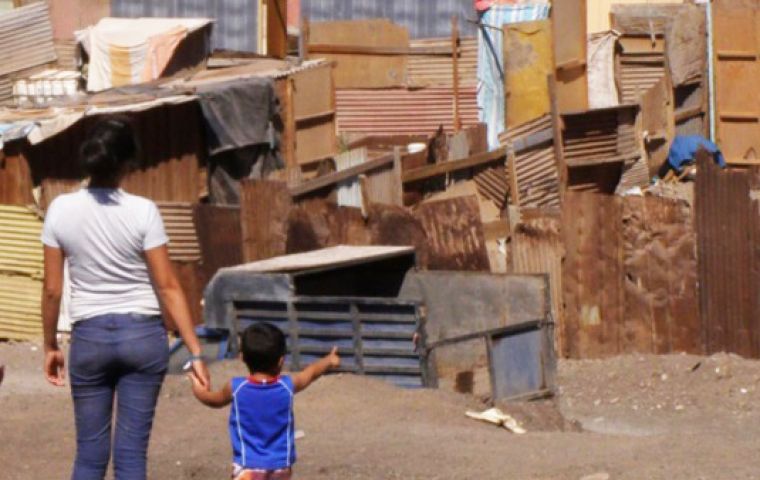MercoPress. South Atlantic News Agency
Latin American poverty and extreme poverty rose in 2015/16 following a decade of decline
 In 2014, 28.5% of the population lived in poverty (168m people), a percentage that increased to 29.8% in 2015 (178m) and to 30.7% in 2016 (186m people).
In 2014, 28.5% of the population lived in poverty (168m people), a percentage that increased to 29.8% in 2015 (178m) and to 30.7% in 2016 (186m people).  “A call must be made to strengthen labor and social protection policies, even more so in periods of low economic growth” said Alicia Barcena
“A call must be made to strengthen labor and social protection policies, even more so in periods of low economic growth” said Alicia Barcena  Social Panorama of Latin America 2017 shows poverty and extreme poverty rates are higher among children, adolescents, young people, women and rural areas
Social Panorama of Latin America 2017 shows poverty and extreme poverty rates are higher among children, adolescents, young people, women and rural areas Poverty and extreme poverty levels rose in Latin America as a regional average in 2015 and 2016, after more than a decade of declines in the majority of countries, while in 2017 they are expected to hold steady, the Economic Commission for Latin America and the Caribbean (ECLAC) said.
In 2014, 28.5% of the region’s population was in situations of poverty (168 million people), a percentage that increased to 29.8% in 2015 (178 million) and to 30.7% in 2016 (186 million people). Extreme poverty, meanwhile, rose from 8.2% in 2014 (48 million people) to 10% in 2016 (61 million people).
Despite these figures, a medium-term perspective leads to a positive balance overall in terms of poverty reduction, since it shrank by 15.2 percentage points between 2002 and 2016, according to the report Social Panorama of Latin American 2017, presented by Alicia Bárcena, ECLAC’s Executive Secretary, at a press conference in the organization’s offices in Mexico City.
Income inequality also decreased between 2002 and 2016, although the pace of the decline has slowed in recent years. The Gini coefficient (where 0 represents no inequality and 1 maximum inequality) went from 0.538 in 2002 to 0.467 in 2016.
“Recent experience indicates that the rise in income among households with the fewest resources has been indispensable to reducing both poverty and income inequality. And this growth has clearly been fostered by countries’ distributive and redistributive policies, such as tax reforms, minimum wages, pensions and transfers linked to poverty reduction strategies and to the expansion of social protection systems,” Barcena said.
For that reason, “a call must be made to strengthen labor and social protection policies, even more so in periods of low economic growth, and to implement the 2030 Agenda for Sustainable Development based on progressive structural change,” the senior United Nations official added. She clarified that, due to the updated methodology used to estimate poverty by income in the region, the values included in the report update the figures presented in previous editions (from 2002 to the present) in order to have a comparable analysis of the phenomenon in the long term, as ECLAC has traditionally done.
Bárcena pledged a detailed report on that methodology will be published along with the country figures, once technical consultations have concluded.
The Social Panorama of Latin America 2017 shows that poverty and extreme poverty rates are higher among children, adolescents, young people, women and the population residing in rural areas. In 2016, poverty affected 46.7% of children and adolescents between 0 and 14 years of age and extreme poverty, 17%. In the case of young people from 15 to 29, these figures were 31.1% and 9.5%, respectively.
The report published by ECLAC also analyzes the evolution and challenges of pension systems, which are fundamental for guaranteeing the rights to social security and social protection in the region in a context of accelerated demographic change. It is estimated that by 2040, people 60 years and older will exceed the number of people from 0 to 14, and that the population 80 years and older will increase by nearly 20 million. There is also a trend being observed toward the feminization of the older adult population.
According to the document, between 2000 and 2014 the contributory base of pension systems in Latin America expanded: the percentage of the economically active population that contributes to a pension system went from 36.9% to 47.8%. This is equivalent to the incorporation of nearly 60 million people to the contributory systems and is associated with the positive evolution of labor markets in that period (especially with the decline in unemployment and increased levels of employment, formalization and labor income), as well as with the implementation of strategies to expand coverage of social security systems in some countries.




Top Comments
Disclaimer & comment rules-

-

-

Read all commentsObviously if you fund your government programs by taxing the future, when you get to the future it will result in hardship because you need to pay for the unfunded programs from the past. In addition you have to ask why if these governments were so successful why did the people replace them?
Jan 02nd, 2018 - 04:09 pm +2Argentina was always announcing growth but at the same time their statisticians were fired and replaced with government loyalists and anyone who published independently collected statistics were prosecuted. Is it any suprise that there is a correction in government statistics now.
Venezuela still have a left wing government. However when the oil price was high there were government services for everyone, now you have to be close to government to benefit from the countries wealth as the socialists look after their friends while leaving the rest of Venezuelan society to fend for itself.
Brazil's left wing President lost her job for misleading the country about economic statisrics.
The people figure out they have been lied to when the statistics say their wealth and standard of living is going up but they struggle more and more. There is a limit to how long the people can be fooled and eventually the politicians are exposed.
“Argentina, Uruguay, Ecuador, Bolivia, Venezuela, had wonderful growths with their timid socialist policies the last decade until 2016 when the black-hands got their ways”
Jan 02nd, 2018 - 05:45 pm +1And where do you live ? Tombouctou ??....(in case you don't recognize the name, try Timbuktu)
EM
Jan 03rd, 2018 - 04:48 pm +1The only unquestionable story in LatAm is how the progressive governments have perpetuated the lack of social justice....under your heroine Dilma, Brazil's GDP 'per capita', between 2012 and 2017 rose......zero %...
But by all means, keep on dreaming in 2018 if it makes you happy !
Commenting for this story is now closed.
If you have a Facebook account, become a fan and comment on our Facebook Page!